
1. Validity
1.1. validity asks the question: is the test measuring what it is suppose to measure?
1.1.1. Three Types of Validity Evidences
1.1.1.1. criterion-related validity evidence is establishing test scores with an external standard or criterion to obtain a numerical estimate
1.1.1.1.1. two types of criterion-related validity evidence
1.1.1.1.2. concurrent: scoring test scores at the same time
1.1.1.1.3. predictive: scoring test scores after a period of time has passed
1.1.1.2. content-validity evidence is comparing a test's item with instructional objectives tosee if they match
1.1.1.3. construct validity evidence is finding corresponding scores with other scores on other variables
2. Reliability
2.1. reliability is when tests consistency yield the same rank, or nearly the same rank, over a repeated time
2.1.1. Methods of Estimating Reliability
2.1.2. test-retest or stability is administering the same test twice to the same group with a small time interval
2.1.3. alternate forms is administering two alternate forms of test to the same group in a short time interval
2.1.4. internal consistency is when getting all test items on a test right
2.1.4.1. internal consistency reliability have two categories
2.1.4.1.1. split-halves is splitting the test into two halves
2.1.4.1.2. odd-even reliability is getting all odd-numbered items in one half and putting all even-numbered items into the other half

